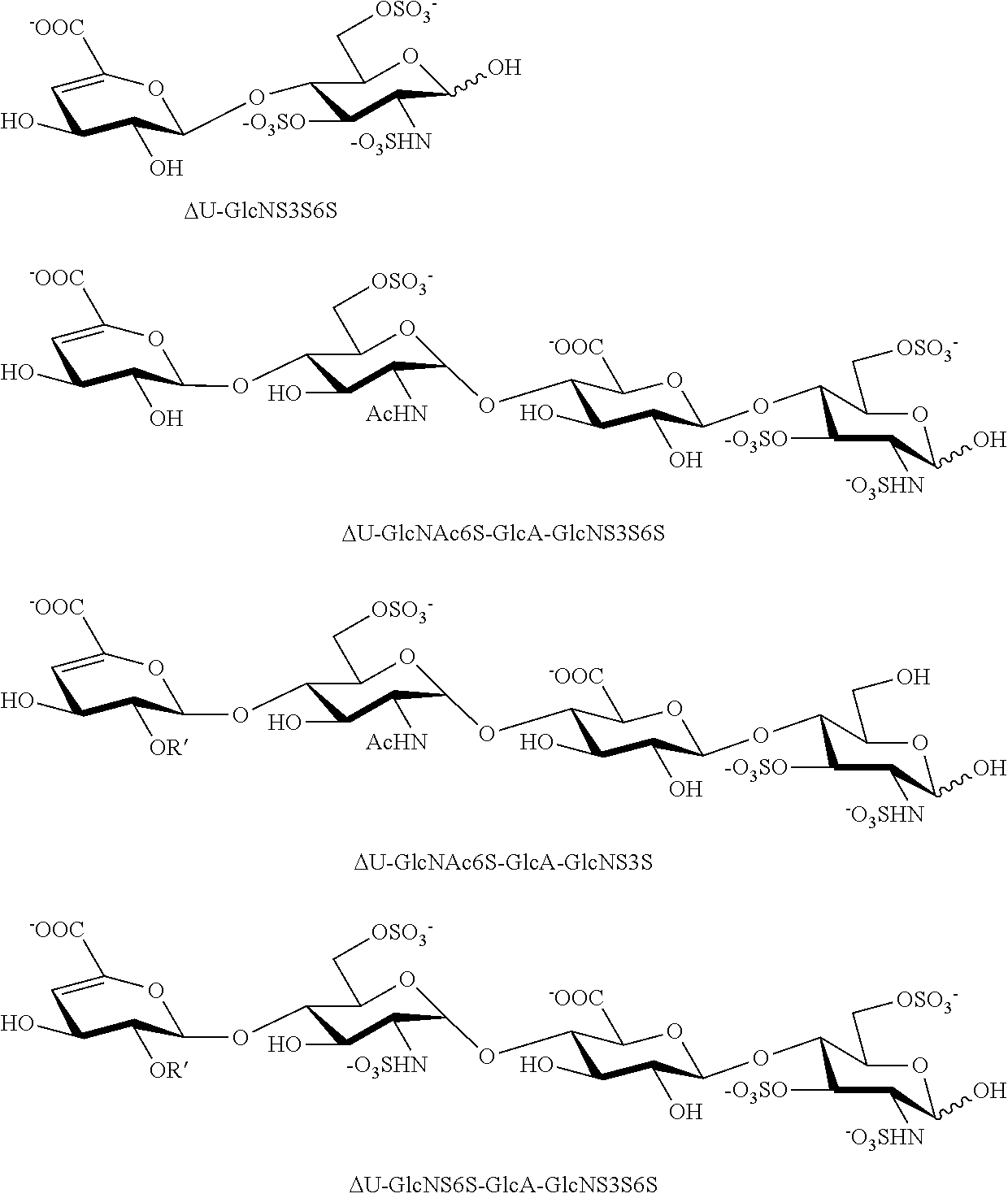Rapid two-step synthesis of Anti-coagulants
- Summary
- Abstract
- Description
- Claims
- Application Information
AI Technical Summary
Benefits of technology
Problems solved by technology
Method used
Image
Examples
example 1
Effective Coupling of Enzyme Activities for Synthesis of an N-Sulfated N-Deacetylated Polysaccharide
[0094]A non-sulfated N-acetyl heparosan (HS) polysaccharide, the compound represented by the structure of Formula III (FIG. 1, step 1) was isolated from the E. coli strain K5 (9), which resembles the unmodified nascent HS chain, and was used as a starting material. Synthesis of an N-sulfated polysaccharide enriched with iduronic acid (represented by the structure of Formula II) was catalyzed by N-deacetylase-N-sulfotransferase (NDST) and C-5 epimerase (step 2). These two initial modifications were the essential gateway for subsequent enzymatic modifications (10).
[0095]A single protein catalyzes both N-deacetylation and N-sulfation. These two reactions are tightly coupled in vivo, since free glucosamine residues are rarely found in HS and Heparin, even though each activity can be studied separately in vitro. The NDST enzyme exists as four isoforms in humans (11). The NDST2 isoform was ...
example 2
N-Deacetylate N-Sulfate Derivatives of Non-Sulfated N-Acetyl Heparosan (HS) Polysaccharide Anti-Coagulant Activity
[0100]The final step was also carried out in the presence of radioactive PAP35S to prepare the radiolabeled compound represented by the structure of Formula I, in order to test its ability to bind to anti-thrombin III (ATIII) by gel mobility shift assay (22). The synthesized compound represented by the structure of Formula I was found to bind to ATIII. In the presence of ATIII, the compound bound specifically to ATIII and hence its mobility was retarded, whereas in the absence of ATIII, the compound migrated more rapidly [FIG. 2].
[0101]A greater percentage of the compound of Formula I bound ATIII as compared to in vitro modified commercial heparin. This result was further confirmed by a heparin-dependent factor Xa inhibition assay [FIG. 3]. The specific activity of the compound of Formula I was approximately 4-5 times that of commercial heparin.
example 3
N-Deacetylate N-Sulfate Derivatives of Non-Sulfated N-Acetyl Heparosan (HS) Polysaccharide Consists of Multiple ATIII Binding Sites
[0102]Finally, the compound of Formula I was subjected to structural analysis following cleavage by heparitinases I, II and III, via capillary liquid chromatography coupled to electro-spray mass spectrometry (LC / MS) (23) [FIG. 4]. The LC / MS analysis showed one major tri-sulfated disaccharide containing a 3-O sulfated glucosamine unit, ΔU-GlcNS3S6S, corresponding to molecular ion 576.0 [M-1H]-1 and two other minor disaccharides, ΔU-GlcNS3S and ΔU-GlcNS6S, corresponding to molecular ion 496.1 [M-1H]-1. The LC / MS analysis also confirmed the presence of many tetrasaccharides, which are resistant to further cleavage by heparitinases, due to the presence of 3-O sulfate groups. These 3-O sulfated tetrasaccharides are: ΔU-GlcNAc6S-GlcA-GlcNS3S6S with molecular ion 517.0 [M-2H]-2; ΔU-GlcNAc6S-GlcA-GlcNS3S with molecular ion 477.1 [M-2H]-2: ΔU-GlcNS6S-GlcA-GlcNS3S...
PUM
| Property | Measurement | Unit |
|---|---|---|
| Composition | aaaaa | aaaaa |
| Coagulation enthalpy | aaaaa | aaaaa |
Abstract
Description
Claims
Application Information
 Login to View More
Login to View More - R&D
- Intellectual Property
- Life Sciences
- Materials
- Tech Scout
- Unparalleled Data Quality
- Higher Quality Content
- 60% Fewer Hallucinations
Browse by: Latest US Patents, China's latest patents, Technical Efficacy Thesaurus, Application Domain, Technology Topic, Popular Technical Reports.
© 2025 PatSnap. All rights reserved.Legal|Privacy policy|Modern Slavery Act Transparency Statement|Sitemap|About US| Contact US: help@patsnap.com



